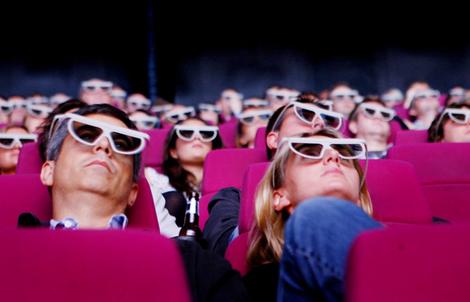3D – Why You Shouldn’t Join The Bandwagon
fernbyfilms.com will remain 3D-free: Here’s why!
People attending any multiplex over the last 12 months or so would no doubt have encountered, if not attended, a film presented in 3D. In the age of BluRay, streaming video online and P2P file sharing, film studios are looking desperately to reclaim some of the market share lost to the (increasingly inaccurately named) home video market. So they’ve come up with a new face for an old gimmick, 3D. And according to viewing figures (if they’re to be believed), 3D films make more money than regular 2D versions do. Of course, this is to be expected when the cinema chains charge an extra two or three bucks to rent some funky 3D glasses for an hour or so, per person per time. Avatar, currently the highest grossing film of all time, may not have been such a performer if it hadn’t had the filmic equivalent of a bottle of Viagra to help it out: 3D market share. Many pundits in the industry have said that Avatar wouldn’t have been as successful had it simply been another 2D film, and I have to say I agree with them.

And now, with the advent of BluRay 3D, as well as the upcoming plethora of televisions capable of displaying the 3D images, viewers will have more choice than ever before. In fact, the film industry is pushing the 3D wagon so fast into peoples lives that I suspect a backlash will occur sooner rather than later.
Box office figures aside, less and less people are able to afford to go the movies, with ticket and candy bar prices the way they are. Here in Australia, tickets costing around $15-$18 are the norm per person, per film. Tack on the extra price for the 3D screening, and suddenly your into the $20 mark. I could buy a standard DVD or a low-price BluRay for that, and watch the film a couple of times. The inflated prices for candy bar goods is another article in itself, so I’m not going to go there this time round, but that’s another ten to fifteen bucks onto your night out. Plus petrol, plus car-parking (if you pay for it) and other ancillary costs, and suddenly, your night at the flicks is going to run you up near on $50! Not cheap!
It’s now that questions must be asked, and to paraphrase David Koepp’s screenplay from Jurassic Park: the studios are so busy thinking about whether or not they can make more money out of 3D, they forget to think about whether or not they should. Is 3D necessarily a good thing for the film industry? Is it a good thing for the greedy corporate suits looking to squeeze even more money out of those unable to afford it? Is 3D worth the extra three bucks to see it in the cinema?
Not everyone can watch things in 3D anyway, due to issues like vertigo, eye strain, and various other complaints. Some have complained that the 3D format causes nausea and induces headaches. Immediately, you have a market excluded from the format. What about blind people? you ask. They’re excluded from film and TV immediately, regardless of format; the counter-argument to that is that there are less blind folks in the world than there are people with plain old bad eyesight. One of our staffers, Greg Bowden, complained that he can’t watch 3D due to his glasses. I tried to watch Journey To The Center Of The Earth a while ago, in 3D, and it made my eyes go funny and gave me a migraine. I have since decided that 3D is not for me, and until the tech improves, have sworn off it altogether.

Recently, the remake of Clash of The Titans was given a post-production 3D-ising, and according to multiple (reliable) sources, it made the film look dreadful. However, Avatar, which was filmed specifically for 3D, looked amazing, by all reports. For those going to the cinema to catch a 3D version of your favourite film, beware. Creating a 3D version of a film which was shot on 2D can often lead to problems, due mainly to headroom issues and other technical glitches. A film shot with 3D in mind has less chance of looking awful and giving you a headache.
Now I don’t mind not being able to watch 3D without getting a headache, because I can simply choose to watch a standard 2D version instead. But to admit to this publicly seems to be currently a way of getting your head torn off on the internet forums. All the studios want to make their films in 3D, and they certainly would prefer you, the viewer, to watch them in that format. I read an online forum where one reader stated he tried to find a 2D screening of Clash of The Titans, only to find he couldn’t locate one anywhere. What? This is what really sticks in my craw. Studios assuming that a 2D version won’t make money, and consequently not giving cinema chains a flat version of the film, reeks of arrogance and a “screw you” attitude you’d think they’d have sworn away from in the aftermath of the BluRay/HD-DVD debacle. Then they start crowing about how 3D “is what the public wants” as confirmation of their decision. It’s not what the public wants you idiots. It’s all you give us! Lack of choice is still a lack of choice, and to say otherwise is lying, straight up.
The other question that needs answering is this: is 3D good for cinema? Truthfully, I don’t think so. Films need to be about storytelling first. Battlefield Earth will still be a shit film if it’s in 2D or 3D: and audiences will figure this out once the novelty of 3D has worn off. And trust me, it will wear off. And then we’ll have to wear the cost for this studio-borne hubris. Inflated cinema prices (because the cinema’s will have installed shiny new digital 3D projection systems, and have to recoup their money somehow!) and fly-by-night BluRay 3D releases with will have a shelf life of maybe a decade or so, as well as the related TV and home-cinema hang-ons, will all suddenly become antiquated relics of a time when somebody thought the look of a film was more important than the story.

People have been asking me if upgrading to 3D is worthwhile. I answer them that it is not. Not only is the technology overly expensive and cumbersome (each pair of those plug-in glasses for your new plasma/LCD/LED Tv costs in excess of $AU150) but will grow tiresome very quickly as people get used to it. Right now, every man and his dog wants 3D. Then again, at one stage everybody wanted a Tamagotchi, and look where that got us. New 3D BluRay players and television screens are about to flood the market, as the major players see all the Avatar cash rolling into their coffers like the greedy mongrels they are. You could almost see the gross national product of Japan increase tenfold in a week when the 3D BluRay specs were released a while back. But there ain’t much software to play on those machines, and the cumbersome technology ain’t gonna impress new viewers to the format. Plus, there are those who’ve been burnt by the BluRay/HD-DVD war that won’t be so eager to get their fingers singed again.
3D has it’s place, and I firmly believe that place is only in cinemas. The home theatre market has taken a battering in recent times with various competing technology trying to outdo each other, and I think this will eventually cause a backlash by consumers who are sick of trying to keep up. BluRay has taken off since the format war, I’ll admit, but compared to DVD here in Australia is still a relatively niche market. Major markets such as the US and Europe have a larger, faster uptake of the new tech, but Down Under is still a small pond. Recent tech releases like the iPad and it’s ilk have again affirmed my belief that companies seeking new technologies to make money from will eventually reach a point where the markets simply can’t handle it any more. Saturation point must be reached.
But I digress.

For film-makers to succeed, first and foremost they need to make a quality film with a decent story, not simply a film designed to showcase the awesomeness of large-screen 3D. Look at Spy Kids 3, for crying out loud. A film designed by a computer programme, directed by a man incapable of cinematic subtlety, and with a story written on the back of a postage stamp, for all the nuances it held. The 2D version of Spy Kids 3 is a cruel and unusual punishment inflicted on humanity, and the 3D version is only marginally better. You can see studios trying to make more films like Spy Kids 3 than films of any quality. And that’s depressing in itself. Reverse-3D-ing films is a bad idea as well. The thought of Luke Skywalker taking Darth Vader to task with his lightsaber in glorious 3 dimensions is admittedly mouth watering, but ultimately a hollow one, because it’s ultimately the story that’s key, not whether or not that lightsaber looks like it’s coming at you out of the screen.
Anybody trolling the various internet forums on DVD, BluRay or film at all, will read for themselves the current backlash on 3D films, especially for the home cinema market. Studios will claim that it’s only those who hate the format who will complain, and there will be many more who won’t say anything, tacitly giving their blessings. I disagree with this: people writing on forums, passionate people who write blog articles and give opinion on subjects (such as we do right here at fernbyfilms.com) are the very people these studios are relying on to get the 3D technology out there. Witness the 3D backlash at sites such as aintitcoolnews.com, hometheatreforum.com, movieblog.com, and even in the comments of Blu-Ray.com. Scroll the comments and make up your own mind. People don’t mind a choice of 3D at the cinema, but the home 3D format is going to come unstuck in a big way, unless major changes are made.
Here at fernbyfilms.com, we’re going to go out on a limb and publicly state that we won’t be actively supporting 3D in the home cinema market. We won’t be reviewing any 3D software on BluRay, due mainly to the fact many people won’t, or can’t, watch it. We’ll remain cautiously optimistic that perhaps the above issues will resolve themselves, although I doubt it. 3D certainly has a market, I’ll grant you, but I think the scale of that market has been blown wildly out of proportion, and studios/electronics conglomerates have gone too far, too fast with the new technology. I guess only the vote of people avoiding 3D films will send those in charge the message. Can’t see it happening within the next few years, but by the end of the next decade, it’ll be interesting to see where things lie.

Interestingly, it appears even acclaimed cinema commentator and critic Roger Ebert dislikes the advance to full 3D as well! Here’s his take on the matter, thanks to newsweek.com.
Tom Clift makes some great points about 3D over at Farrago. You can read his article here.


Do you still feel this way Rodney?
Yeah, I kinda do. 3D is still not quite hitting mainstream even now (most people prefer regular 2D for the most part) so I think I've been vindicated somewhat. Ask again in another 12 months and things may have changed completely. 3D is still a gimmick, and one I think will remain an extra, instead of the default.